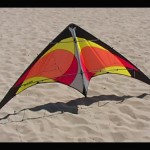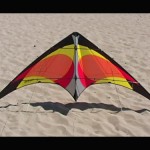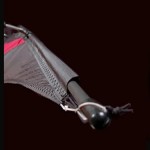 Specifications
Specifications
Manufacturer: New Tech Kites
Model: Big Bang
Wingspan: 92 inches
Height: 40 inches
Standoff depth: 9 3/4 inches
Weight: 12 oz
Type of kite: Slack line trick kite
Materials: Full Skyshark P200 frame, Nylon sail, APA connectors.
Source for test kite: Manufacturer
Kitelife.com got a hold of a Big Bang from New Tech Kites and sent it out to me for a review. The kite has been on the market for a month or two, and I have been reading comments from flyers on the web forums. Now it is my turn to see what this kite is like.
First I will cover the construction of the Big Bang, and then the flight.
Quality of Construction
The quality of construction is quite good. I found no problems with the stitching and all sail panels are neatly trimmed. Zig-zag stitching is used between the sail panels and a straight stitch is used on the dacron reinforcement patches. There is dacron reinforcement along the leading edge, at the nose, where the upper spreader crosses the spine, around the center T, at the tail, at the sail standoff connectors, and along the trailing edge. The standoff connectors are covered on the backside of the sail with dacron patches so that the lines won’t catch. There is plenty of dacron at the reinforced areas, except around the sail standoff connectors, but hopefully the amount is sufficient. I did not notice any stretching of the nylon sail at the standoffs after a week of flying. There is also a strip of Mylar reinforcement along the entire spine. All-in-all, the Big Bang is a solidly made kite with a stiffness that I like.
Connectors are APA and Jaco. The LE edge connectors and center-T are held in place with rubber O-rings. There are white marks on the LE to align the O-rings in the proper place. So far, after a week of flying, they have held in place. The center-T is made from rubber instead of plastic and has a neck that flexes a little. I am not sure how this will last over time. One side of the center-T hole that the spreader ferrule goes through is tighter in diameter — just enough so the ferrule goes in without too much effort, but with a snug fit to hold it in place.
The upper spreader (US) is held to the spine with another O-ring. Since the US is also a P200, it is a tight fit. The O-ring keeps the US attached to the spine so you don’t loose it and may also help stiffen the kite when in flight, but I would prefer to take the O-ring off. I think it is more hassle than it is worth.
To smooth out the leading edge (LE), there are plastic strips that insert under the dacron leading edge material and go over the LE connectors. These are known as yo-yo glides. All four LE connectors have them. There are yo-yo stoppers installed, which are spreader standoff connectors slid over the LE rods. There are also long strips of nylon tape over the nose piece to smooth out this area and prevent snags. After flying for a week, the tape is starting to peel back, but it can easily be replaced.
The sail is tensioned with a dacron line that has a knot that catches in the slit of the nock. There is also a leech line with loops that go in the nock slits. Rubber end caps are included to cover the nock, but I could not get them on that easily after the tensioning line was in place. While flying on soft sand, one of the nocks did crack for no apparent reason, but I was able to secure it with vinyl tape.
The Big Bang has three standoffs per side. The two inner standoffs are stiff carbon and the outer one is fiberglass that is bent quite a bit to tension the trailing edge. The endcaps on the standoffs are pretty small and two of them fell off right away.
Velcro is used at the tail to tension the spine. The velcro strip wraps around a nice T-fitting at the end of the spine.
The kite comes with three 10 gram milled “donut” wieghts that slide over the spine and are held in place with rubber O-rings. It is easy to position the wieghts, but not so easy to get them on and off the spine. To do this, you need to remove the lower spreaders from the center-T, pull the spine out of the nose, and then slide it out of the tail velcro. After a first flight with the weights, I decided the kite did not need them and took them off for the rest of my test flying. I have heard that the weights may slide a bit along the spine if you do much rigorous pitching.
Extras
The Big Bang comes with a nice padded sleeve that either folds in half to hold the disassembled kite or extends to hold the assembled kite. There is a zipper at one to open and close the sleeve. An inner pocket holds a line set and other goodies, such as the weights you are not using, but be sure they are in a plastic bag, or something, because they can easily fall out.
The Big Bang comes with a generic New Tech instruction booklet that shows details on how to assemble and tune a kite. It also covers flying basics and describes a number of tricks.
The kite also comes with 100′ Dyneema line, wrist straps, and a winder. The line is medium quality, and the length of my lines were different by two inches. This could really throw off a newer flyer. A slight difference in length is not uncommon, but I would need to cut the longer line and resleeve in order to take up this much length. So after a first flight, I used one of my other linesets.
Finally, the Big Bang comes with the Dodd Gross Flight School DVD. This DVD covers a lot of material. Dodd’s style is somewhat casual without much focus on detailed technique, and the trick explanations go by quickly, so you really need to pay attention and watch over and over. A picture in picture mode lets you see the kite and Dodd’s movements at the same time. Fortunately, the DVD allows you to watch one trick at a time, or watch through all the tricks in a trick family. The navigation is a bit tedious because of multi-levels of menus and lots of indexed tricks, but if you want to find one trick and work on it, you can do that pretty easily. Dodd gives good tips throughout from his flying experience and also provides additional footage of freestyle flying. Anyone wanting to learn tricks can make good use of this DVD, especially if you already have a little experience.
Bridle
The bridle is active with a design that comes from Andy Wardley. It is basically like a turbo bridle with a long turbo leg and an extra line between the upper outhaul and inhaul. The bridle legs are fairly short. The bridle is adjusted by sliding the pig tail up and down to trade off length between the upper and lower outhauls. I adjusted the bridle a little during my flying, but not much.
Design Features and Tuning
The Big Bang is a straight forward kite. Because of the active design, I would not play around with the bridle too much except for the pigtail adjustment. In that regard, a more standard 3-point or turbo bridle would be more tunable. Of course, the kite comes with the weights, so you can add 10, 20, or 30 grams anywhere along the spine. The kite already comes with the yo-yo stoppers and glides installed.
Wind Range
The Big Bang is a bit heavy. This weight provides good momentum for slack line tricks, but you need at least 5 mph to fly this kite very successfully. I like the way the tricks look in low wind, but it is very hard to keep the kite in the air — the Big Bang has very little float and has a lot of momentum to control when rotating. I flew the kite every evening for a week and over two weekends. I often had 3 to 5 mph wind, but also had some days of 8 to 10 mph. Unfortunately, I never had strong enough wind to test the upper limit, but the kite has very little pull and tricks are initiated quickly, so it can probably handle a pretty good breeze.
As for lines, I used 90# at 100 ft and 85 ft, which both were fine. The Big Bang is quite maneuverable.
Amount of Pull and Sensitivity
The Big Bang has light pull and is quite sensitive to initiate and control most slack line tricks. Some tricks do take more effort, which you will learn as you fly. You can easily over react with this kite until you get used to it.
Unusual Flight Behaviors
The nose wants to sit high in a fade. The bridle lines cross the leading edge too far back for my liking, and I find it challenging to roll the kite out of a fade or initiate a good backspin without choking it.
The nose also tends to go high in axels and 540s. In axels, the kite can feel like it is rolling over itself. This isn’t as apparent in light wind, but is more noticable as the wind gets stronger. Since the wingtips are low, it is easier to snag the wingtips.
The kite pitches very quickly, which is great for some things, but not so good for others that involve balancing on the belly or back.
It is hard to keep the kite in a backflip; the nose wants to rise up. The high nose also makes the last half of jacob’s ladders challenging.
Strongest Tricks
The Big Bang is very quick at rotating, especially pitching. Flic flacs are fast and crisp and use little vertical space. Cascades are also quite snappy and clean. The kite rolls up very easily, flies rolled up, and unrolls nicely, even without the weights. I didn’t see a need for the weights; perhaps in heavier winds. The kite needs small inputs to initiate tricks, so it is easy to get the kite rotating one way or another when going into a slack line trick. I could also get nice snap turtles.
Most Challenging Tricks
The most challenging trick for me was the jacob’s ladder and anything that involves rolling out of a fade. I also got more tip wraps than usual during some axels and many 540s because the wing tips tend to hang down as the kite spins. Though most tricks take a light input, the pop to get the 540 to spin needs to be strong and quickly followed by lots of slack.
The Big Bang does not sit in a backflip for very long, so once on its back, you need to move on to the next trick without delay.
Precision (corners, tracking, speed)
Assuming you have good wind (over 5 mph) the Big Bang has decent precision. The tracking is solid and snap stalls are surprisingly stable. Corners are not very sharp, but wobble is minimal. Forward speed is slower than I expected considering how quickly the kite tricks. The kite spins tightly. The Big Bang does not inspire precision flying, but it is good enough to satisfy between the slack line tricks — better than many trick kites of the past. The stable feel of precision-type flying is a nice contrast to the lively trick feel.
Flying Experience
Slack line tricks are quite quick with this kite, too quick for my taste. There is also quite a bit of momentum in rotation, so things can get a little jerky. I like some floatiness here and there, but the Big Bang has no time for that. It also rarely feels balanced. The kite is so pitch happy that the balance and quality of other tricks are impacted. After flying my other kites, it took me quite awhile to adjust to the Big Bang. Light, quick, snappy inputs are needed. You can’t really guide the kite through slack line tricks. If anything, be sure the lines are out of the way. If you are just flying figures, and there is enough wind, the kite feels pretty solid and stable, but once you get into the slack line tricks, you may feel a little loss of control and the wild side of the Big Bang kicks in. I do not consider this a beginner level kite. It would be better for someone with slack line trick experience.
Summary
 If you are looking for a kite that tricks quickly and combines a wild slack line side with fairly stable figure flying, then consider the Big Bang. The quality is good, the kite feels solid, and it behaves well for precision style flying yet can quickly launch into some radical slack line tricking. The kite is a great value for the money, especially with the extras.
If you are looking for a kite that tricks quickly and combines a wild slack line side with fairly stable figure flying, then consider the Big Bang. The quality is good, the kite feels solid, and it behaves well for precision style flying yet can quickly launch into some radical slack line tricking. The kite is a great value for the money, especially with the extras.
Personally, I did not connect well with the kite and found it frustrating to fly. Even after flying it for a week, I did not have much fun with it. The problems with the nose riding high and the challenges of rolling out of a fade quickly diminished my enthusiasm. Also the tricks happen too quickly, without enough of the float and balance that provides the magical quality that I like. The ease with which the kite rushes into tricks does provide a nice thrill, though.













